
Whisker Secrets of Cats
Leave it to Otto to inspire today’s post about whisker secrets of cats.
He has a bevy of magnificent whiskers and not just in the usual location. Check out your cat and see if they have these special ones too.
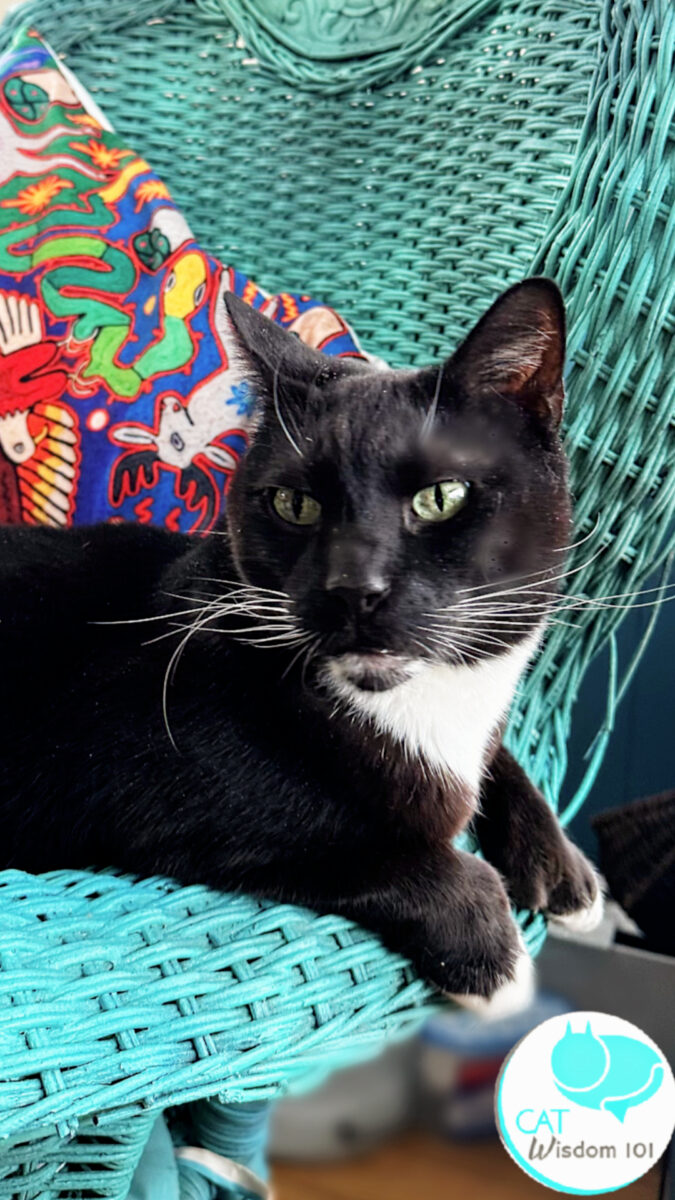
Whiskers serve as a vital sensory and navigational system, connected to nerve bundles that act as receptors, making cats incredibly adept at detecting subtle movements.
Cats typically have about 24 whiskers, evenly distributed on both sides of their face, including muzzle, chin, and eyebrow whiskers.
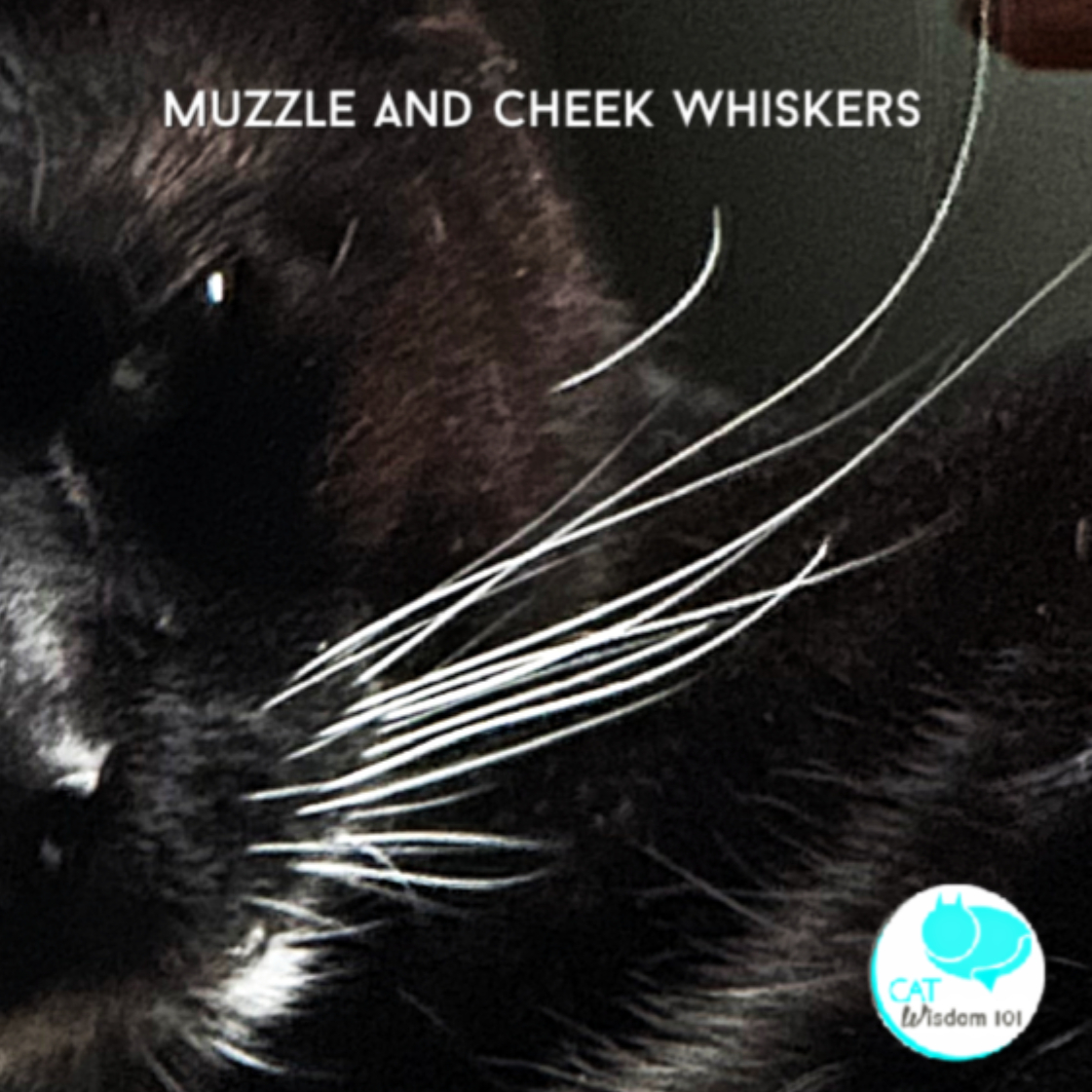
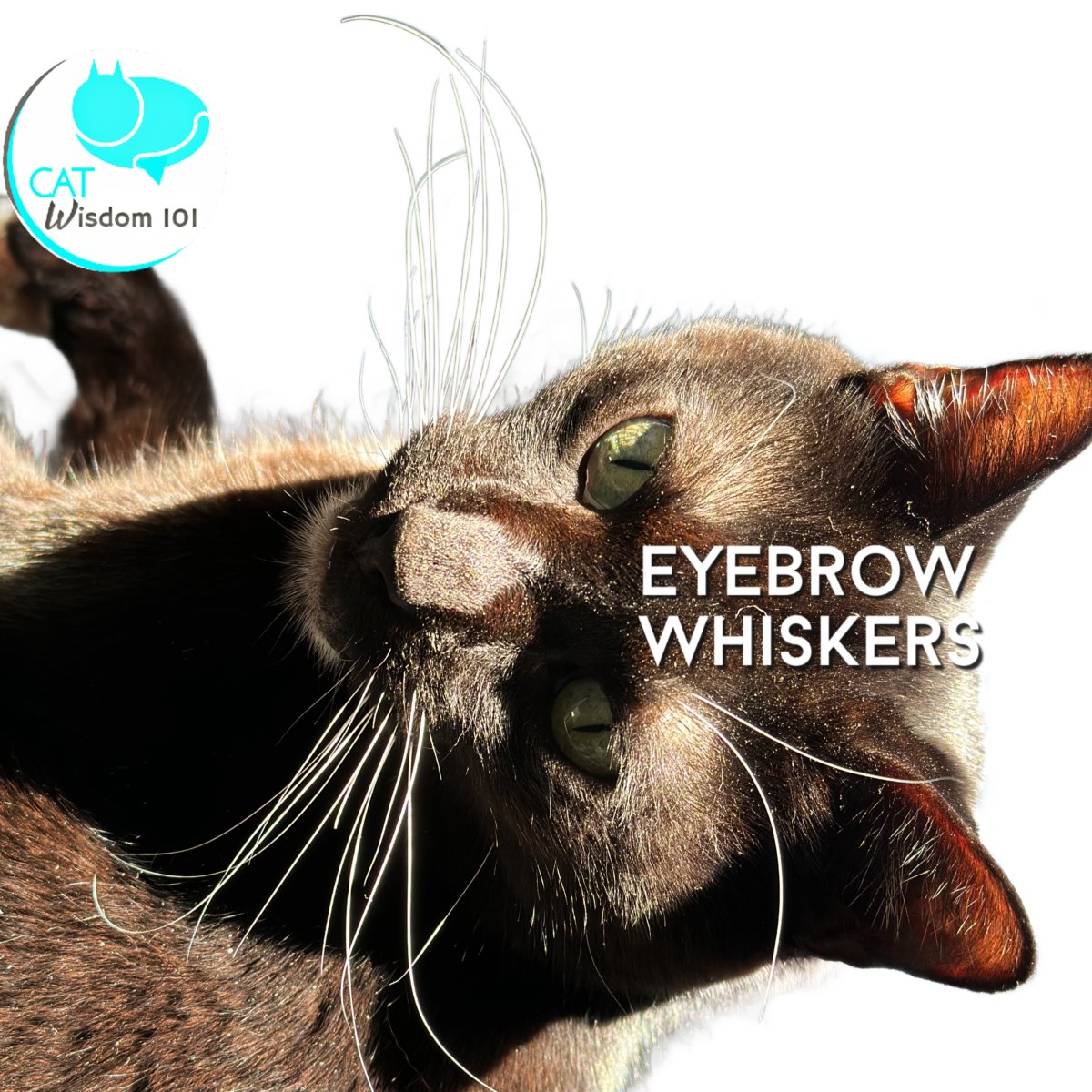
Remarkably, whiskers are the first hairs to develop in the womb, and they offer valuable cues about a cat’s mood and surroundings. Whiskers can signal fear, anxiousness, aggression, pain, friendliness, and interest, reflecting a cat’s intricate personality and behavior.
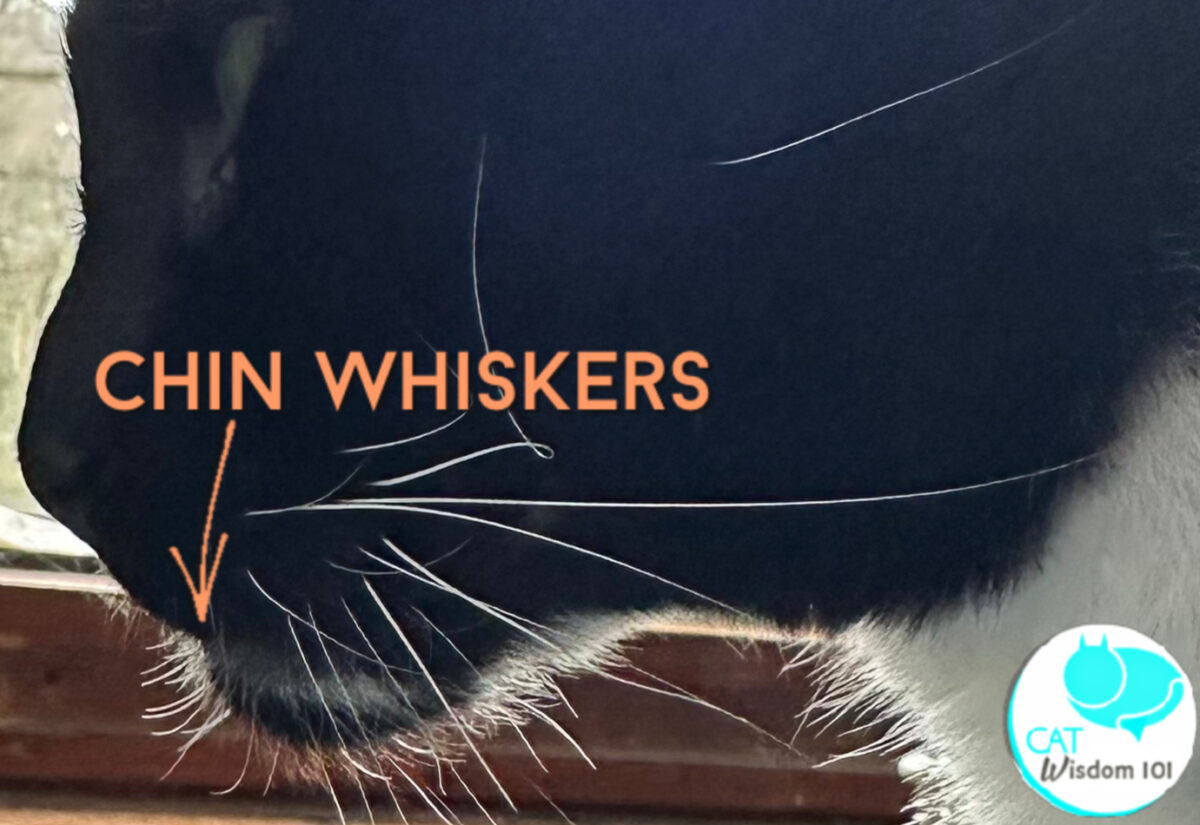
Whiskers are usually white but black in all black cats and controlled by the agouti gene, responsible for whisker coloration and intriguing fur patterns in cats.
These vibrissae, as they’re also known, are not only a measuring tool for spaces but act as a natural ruler matching a cat’s body width. Additionally, whiskers vibrate, enhancing sensitivity to air movements, aiding navigation in darkness.
As cats age, their whiskers may change color, and whiskers play a role in their self-grooming routine, facilitating precise grooming without direct contact.
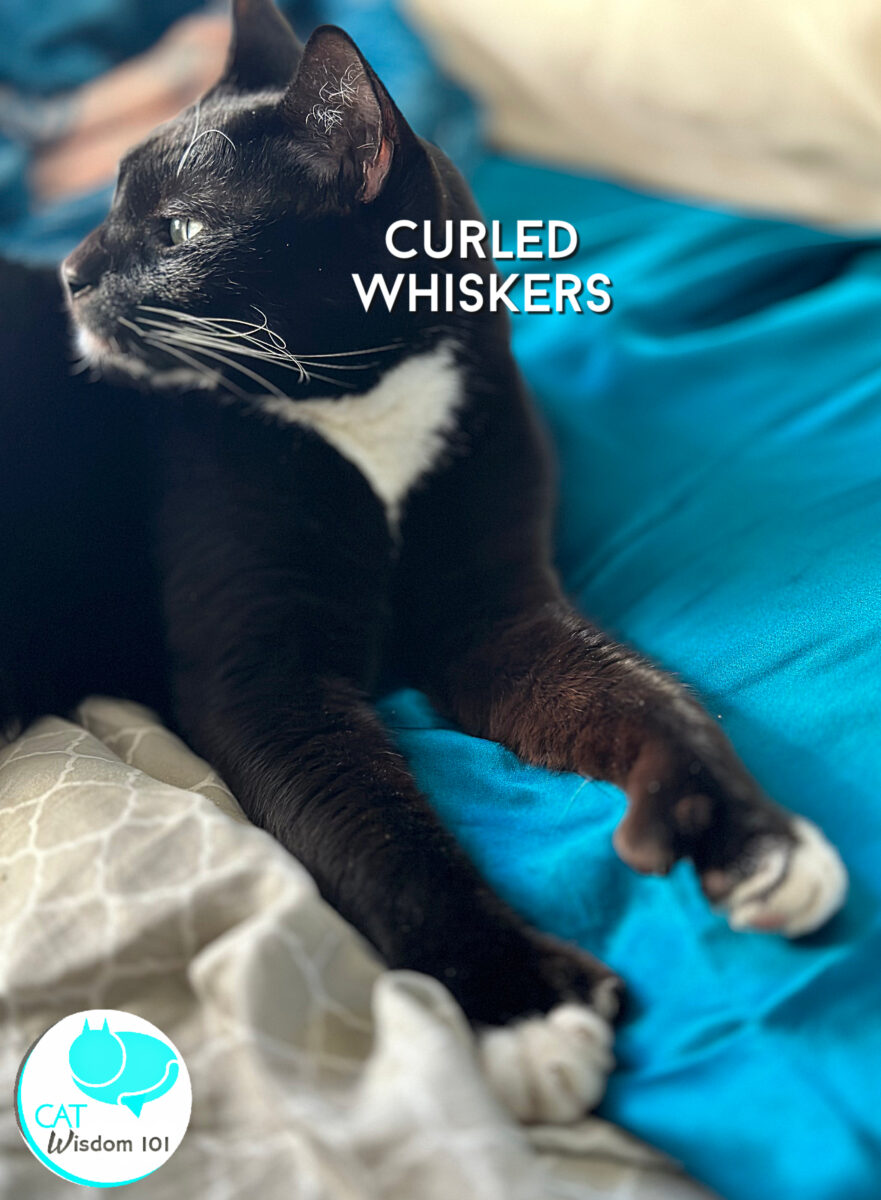
Curled whiskers?
Here are a few points about cats with curly whiskers:
1. Rex Breeds: Some cat breeds that are part of the “Rex” category, known for their curly fur, may also have curly whiskers. For example:
• Cornish Rex: Known for their short, wavy coat, Cornish Rex cats may have curly whiskers that complement their overall curly appearance.
2. Individual Variations: Curly whiskers can occur in individual cats outside of specific breeds. It’s a genetic variation that might not be associated with any particular breed traits.
3. Genetic Factors: The curliness of whiskers, like the curliness of fur, is often influenced by genetic factors. It can be an inherited trait that is passed down through generations.
4. Normal Variation: Just as whisker length, color, and thickness can vary among cats, so can the degree of curliness. It’s a normal variation in the fascinating world of feline genetics.
5. No Health Concerns: In general, curly whiskers are not a cause for health concern. They are simply a unique feature that adds to a cat’s individual charm.
If you have a cat with curly whiskers, it’s a delightful and distinctive characteristic that makes your feline friend even more special.
All about leg whiskers!
Carpal whiskers, also referred to as carpal vibrissae, are remarkable sensory hairs located on the back of a cat’s front legs near the carpus, akin to the human wrist. These whiskers play a vital role in enhancing a cat’s spatial awareness and environmental perception.
1. Purpose and Sensitivity:
Carpal whiskers are exceptionally sensitive, capable of detecting minute air movements and subtle changes in their surroundings. Their primary purpose is to provide cats with detailed information about surfaces and objects close to the lower part of their body, aiding in navigation and exploration.
2. Navigational Aid and Adaptation:
These whiskers contribute to a cat’s ability to navigate various terrains effectively. Whether a cat is traversing uneven surfaces, exploring new spaces, or engaging in activities close to the ground, carpal whiskers serve as adaptive tools that enhance the cat’s overall sensory experience. Apparently, they help cats climb trees and Otto agrees.
3. Color and Thickness:
Carpal whiskers, like facial whiskers, can vary in color and thickness. The color of these whiskers often matches the cat’s fur color.
They can be white, black, or a combination of colors, depending on the individual cat’s coat.
I had a hard time locating Odin’s leg whiskers since are are fine, white and look like his fur.
The thickness of carpal whiskers may differ from facial whiskers, with some cats having finer or thicker hairs in this region.
4. Communication and Social Interaction:
While facial whiskers are more prominently associated with communication between cats, carpal whiskers can still play a role. During social interactions or play, these whiskers may provide additional tactile information, contributing to the cat’s understanding of its surroundings and interactions with other cats.
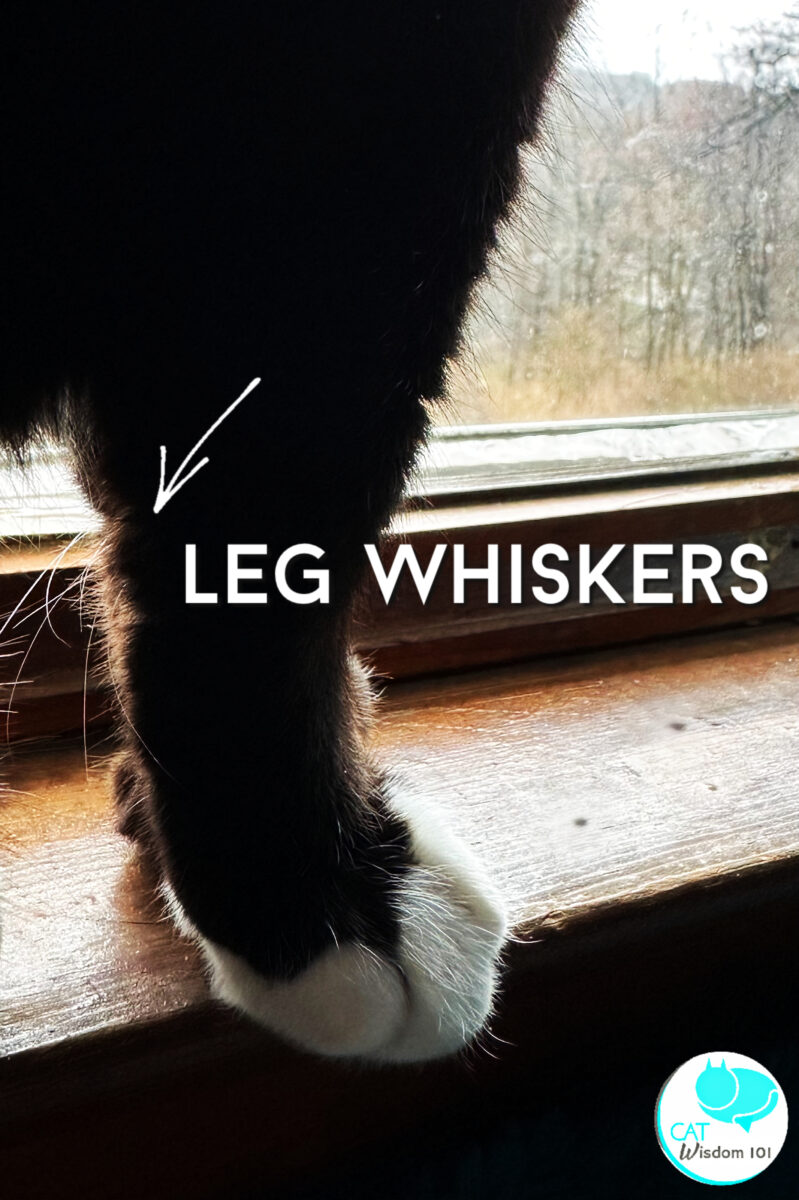
Who has the best whiskers?
This is of course subjective but I’ve found black and tuxedo cats have extra long or thick ones.
While there is some variation among individual cats within a breed, certain cat breeds are known for having particularly long or thick whiskers.
Here are a few examples:
1. Maine Coon: The Maine Coon is a large cat breed known for its tufted ears, bushy tail, and tufted paws. They often have long and sturdy whiskers that complement their overall size.
2. Persian: Persian cats one of the most common cat breeds are recognized for their luxurious, long fur, and they may also have relatively long and fine whiskers. Their gentle and calm demeanor adds to their regal appearance.
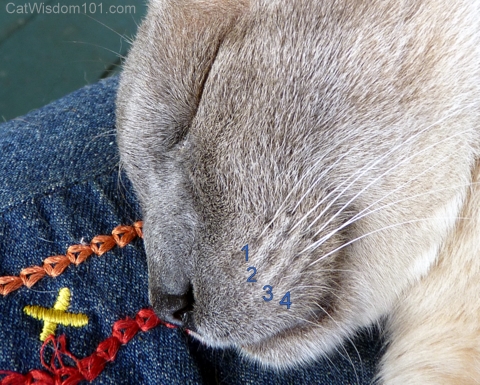
3. Siamese: Siamese cats are known for their striking blue almond-shaped eyes and short coat. While their whiskers may not be exceptionally long, they are often fine and in proportion to their sleek appearance. My Merlin ( above was a good example).
4. Siberian: The Siberian cat known for its thick triple coat and large size, may have long and substantial whiskers. This breed’s whiskers contribute to their overall well-balanced and robust appearance.
5. British Shorthair: This breed is characterized by its round face, dense coat, and large, round eyes. British Shorthairs may have whiskers that are proportional to their face, contributing to their charming and endearing look.
It’s important to note that individual variations exist, and whisker length or thickness can vary even within a specific breed. Additionally, mixed-breed cats can exhibit a wide range of whisker characteristics. If you’re interested in a cat with specific whisker traits, it’s a good idea to observe the individual cat rather than relying solely on breed generalizations.
Missing Whiskers?
Whiskers, or vibrissae, can fall out for several reasons, and it’s a natural part of a cat’s hair growth cycle. Here are some common reasons why whiskers may fall out:
1. Normal Shedding: Just like other hairs on a cat’s body, whiskers go through a natural shedding process. Old whiskers fall out as new ones grow in, ensuring the vibrissae remain functional and sensitive.
2. Stress or Illness: Cats can experience hair loss, including whisker loss, due to stress or illness. If a cat is going through a period of stress, anxiety, or if they are unwell, it may affect their overall coat health, including the whiskers.
3. Accidental Trimming: Occasionally, whiskers may be accidentally trimmed during grooming or other activities. Cats are generally meticulous groomers, and if they inadvertently chew or cut their whiskers, they may fall out.
Never cut your cat’s whiskers!
4. Natural Breakage: Whiskers are long, sturdy hairs, but they can still break due to various activities. Rough play, encounters with sharp objects, or getting caught in tight spaces might result in the breakage and subsequent loss of whiskers.
5. Age: As cats age, the texture and thickness of their whiskers may change, and they may be more prone to breakage or falling out. This is a normal part of the aging process.
It’s important to note that while occasional whisker loss is normal, excessive or sudden whisker loss may be a sign of an underlying health issue. If you notice a significant change in your cat’s whisker condition, coupled with other concerning symptoms, it’s advisable to consult with a veterinarian for a thorough examination.
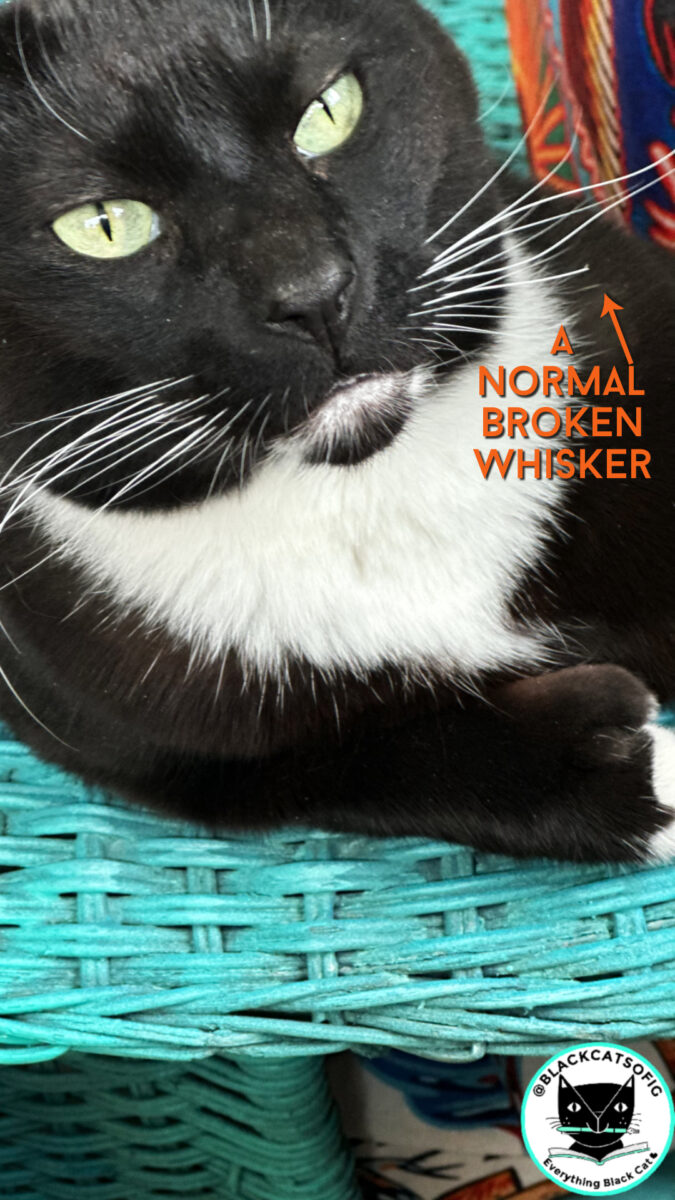
Cats use the positions of their whiskers to convey various emotions and moods. Here are some common whisker positions and their potential meanings:
Sideways or Pulled Back: If a cat pulls its whiskers tightly against its face or flattens them sideways, it can indicate aggression, irritation, or discomfort. This whisker position may be a warning sign that the cat is not in a friendly mood.
Whiskers Pointing Down: Drooping whiskers may be a sign of illness, fatigue, or general lethargy. Cats may display this position when they are not feeling well or are experiencing a low energy state.
Twitching or Vibrating Whiskers: Rapid movement or vibrating of the whiskers can indicate excitement, curiosity, or anticipation. Cats may exhibit this behavior when they are exploring or investigating something interesting.
Tight or relaxed?
Relaxed Fanned Out Whiskers:
When a cat’s whiskers are gently fanned out to the sides, it typically indicates a state of relaxation and contentment. This is often seen when a cat is in a comfortable and secure environment, enjoying a peaceful moment.
In the case of Otto shown here in his cage at the shelter, he’s in his usual friendly outgoing mood.
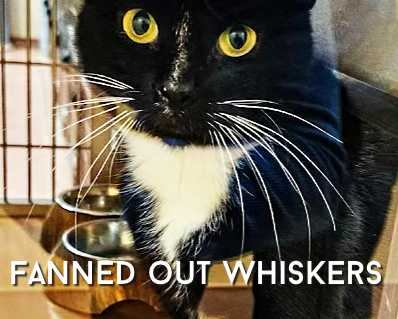
Straight and Tight Whiskers:
Whiskers pulled straight and tight against the face can suggest alertness and focus. This position is commonly observed when a cat is intensely concentrating on something—whether it’s stalking prey, closely observing an object, or feeling slightly wary in a new environment.
It’s important to consider these whisker positions in conjunction with other body language cues to accurately interpret a cat’s mood. For example, a cat with straight, tight whiskers may be exhibiting focused attention, but other signs like dilated pupils or a raised tail could indicate excitement or potential stress.
As with any aspect of feline behavior, individual differences exist, and some cats may exhibit variations in whisker positions based on their unique personalities and experiences. Regular observation and an understanding of your cat’s typical behaviors will help you interpret their whisker positions more accurately.
Otto’s whiskers were tight and straight on his first day in his new home.
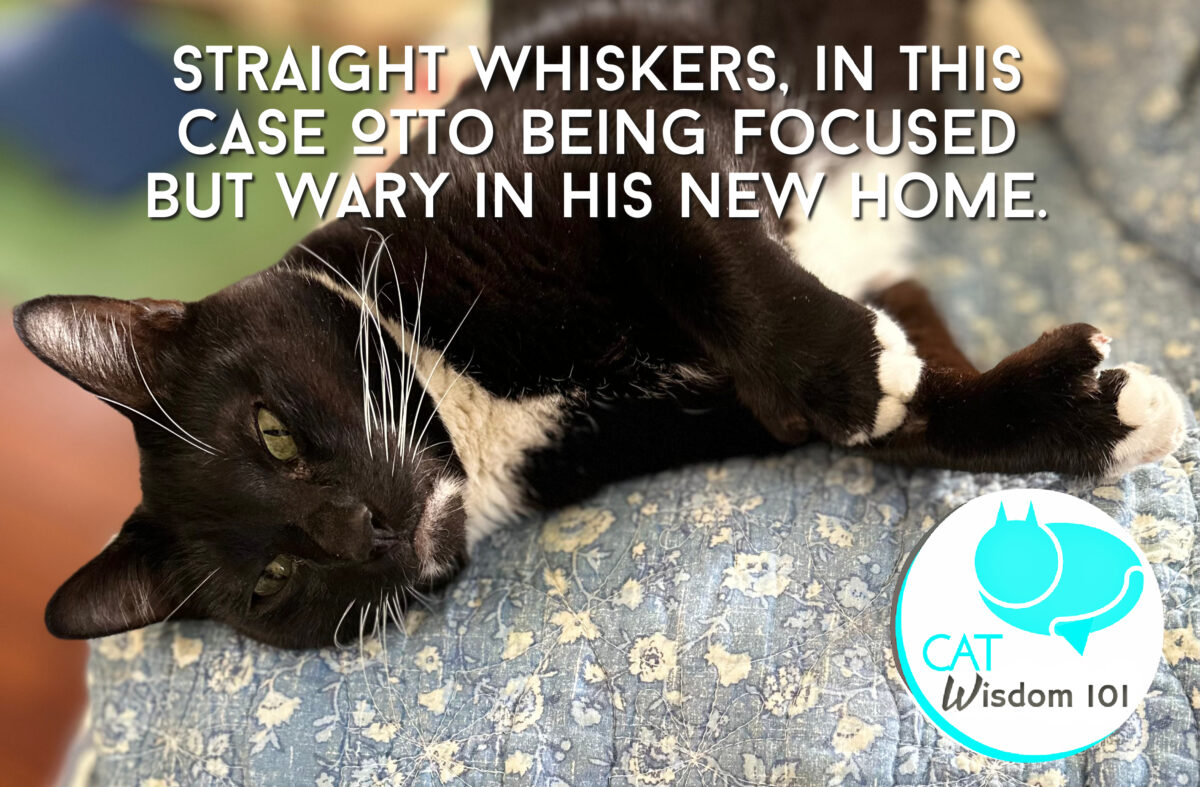
Whisker Stress?
This was a big thing a few years ago, but it’s never been an issue for my cats. I’ve experimented with every possible kind of bowl and bigger and elevated is better.
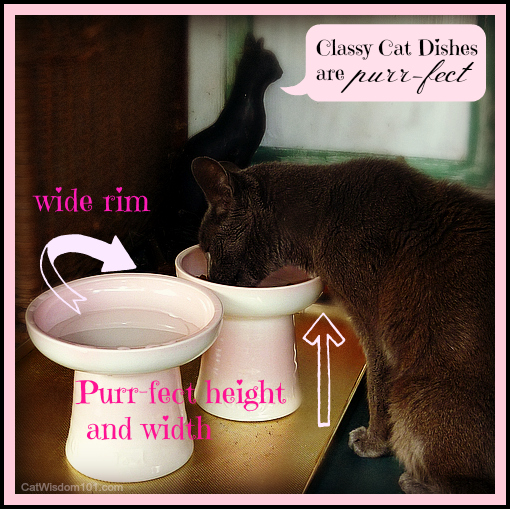
Cats can be sensitive to the type of food and water bowls they use, and this sensitivity extends to their whiskers. Some cats may experience discomfort if their whiskers touch the sides of a bowl while eating or drinking. This is known as “whisker fatigue” or “whisker stress.”
Here are a few considerations related to whisker sensitivity and bowls:
1. Wide and Shallow Bowls: Cats often prefer wide and shallow bowls that allow them to eat or drink without their whiskers touching the sides too much. This design minimizes whisker stress and provides a more comfortable dining experience.
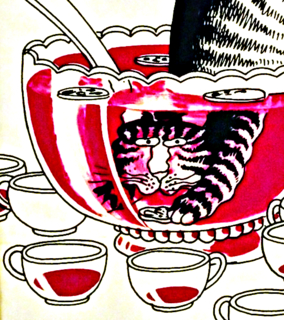
2. Avoiding Deep Bowls: Deep bowls, especially those with high sides, may cause a cat’s whiskers to touch the sides, leading to potential discomfort. Cats may find it less stressful to eat from bowls that don’t force their whiskers into close contact with the edges.
3. Multiple Bowl Options: Offering different bowl options gives your cat the opportunity to choose what feels most comfortable for them. Some cats may prefer a shallow dish for food and a separate water bowl.
4. Material Matters: Some cats may be sensitive to the material of the bowl. Stainless steel or ceramic bowls are often preferred, as they are smooth and don’t retain odors like some plastic bowls which can cause chin acne
Observing your cat’s behavior during mealtime can provide insights into their preferences. If you notice signs of whisker stress, such as reluctance to eat or pawing at the food, consider trying different bowl options. Ultimately, providing a comfortable and stress-free eating environment contributes to your cat’s overall well-being.
Does your cat have unusual whiskers or anything to add to whisker secrets of cats?



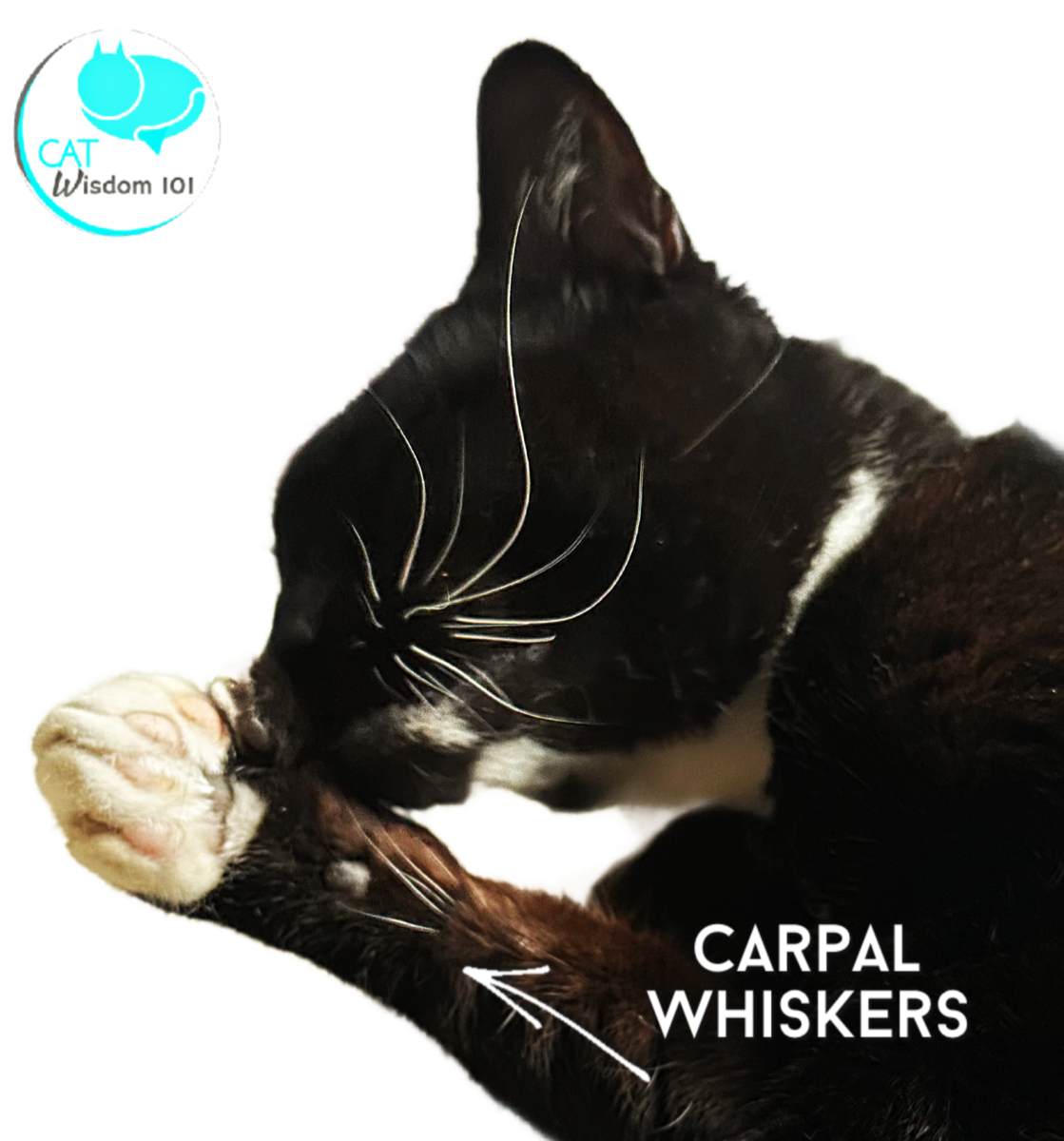
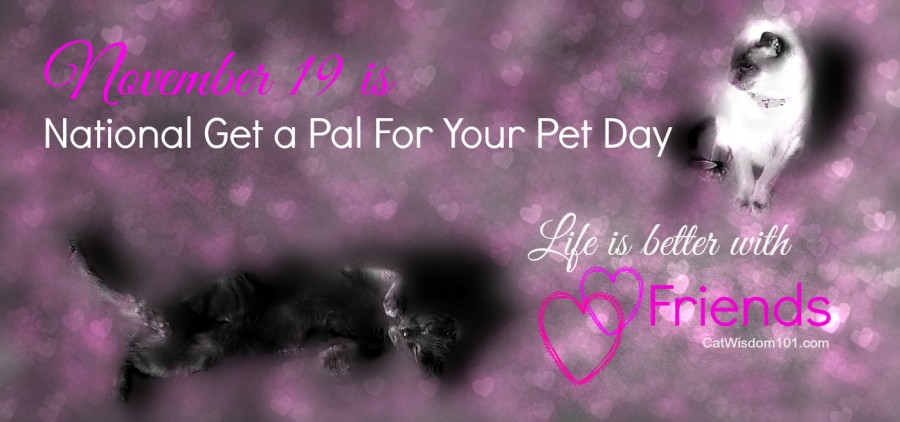
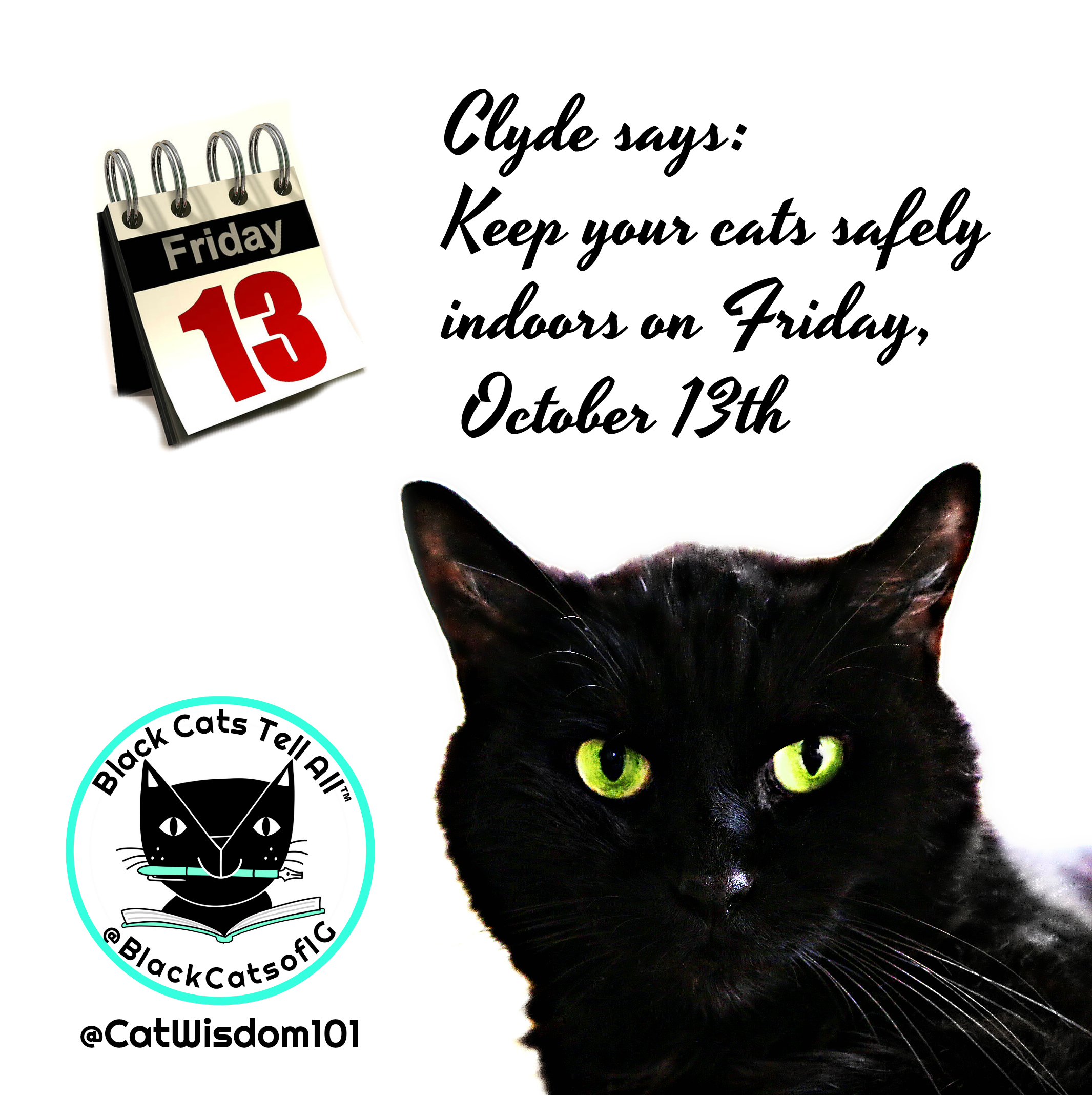
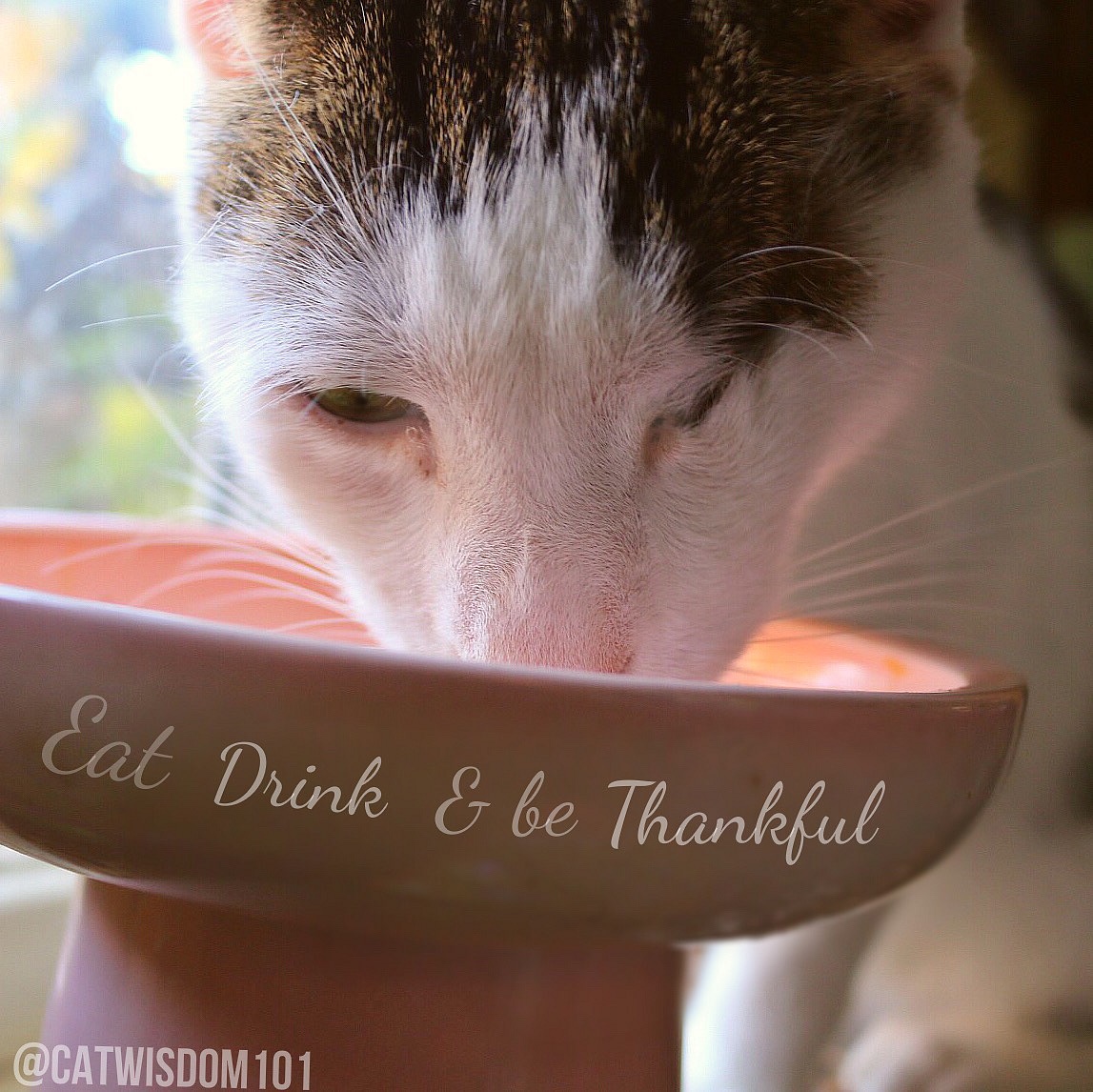
12 Comments
meowmeowmans
Great and very interesting post, Layla! Gracie had all black whiskers until she was about 18. Then she started having some white ones!
Layla Morgan Wilde
That’s very interesting for the switch so late in life!
Ellen J Pilch
Very interesting post.
Meezer'sMews&TerrieristicalWoofs
Veruy informative post! I learned some new thiongs about kitty whiskers today!
I wonder if dog whiskers function. similarly?
Layla Wilde
Thanks! Dog whiskers are thicker and stick out all the time while cats can retract theirs. There are other differences too but I’d have to write an article 😉
Brian's Home Blog
That was very interesting and Otto, you have some amazing whiskers!
Layla Wilde
Thanks so much and I’ll tell Otto! He loves compliments.
Amy Harlib
My all black Maine Coon mix Astor-kitty at age 4, has lovely whiskers.
That was a very interesting article with terrific photos.
Layla Morgan Wilde
That’s funny! Odin singed a whisker once and never again🙀
Karin Erickson
This was a very interesting article. I learned a lot from it. I have a black cat, Buddy, who has black whiskers and he has some behavioral issues. I know all the signs to look for with his pupils, his tail, his posture, his ears, but I didn’t know to check the whiskers. I will keep this in mind and if it’s light enough in the room when he’s acting up, maybe I’ll be able to see them.
Layla Morgan Wilde
Thanks, Karen! When my all black cat Clyde was alive, I’d examine him in a sunny window and that made it easier.
Memories of Eric and Flynn
Most of the time Eric had long fanned out whiskers, but when it was cold in winter he would get too close to the log burner. That resulted in him having shorter curly whiskers. No matter how often we moved him back he would creep right back again.